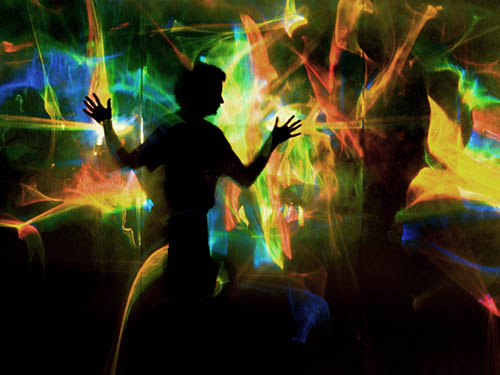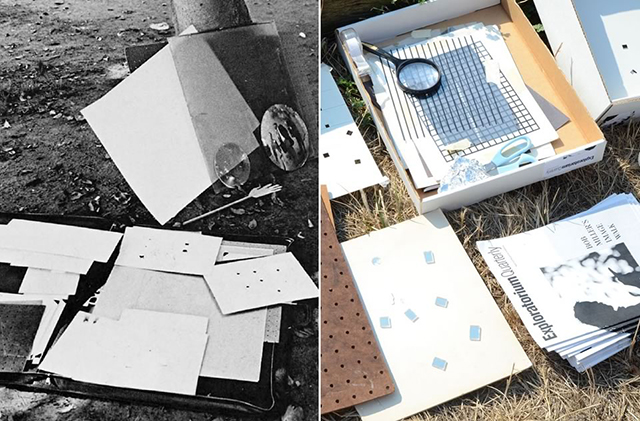Until February 5, 2015, you can visit the main branch of the San Francisco Public Library and be momentarily transported through space and time to the early days of the Exploratorium via the life and work of Bob Miller, who died in 2007.
The transportation isn’t entirely complete, especially when unavoidable elements of the library’s physical space interrupt the installation of vitrines, wall text and objects. But reading first-hand accounts by Miller’s colleagues of his various contributions to both the Exploratorium and scientific discovery, I wished I’d wandered the museum with him at any point in his twenty year tenure. Documentation and ephemera will never be as entertaining as the man himself, but Light Walk: Bob Miller and the Exploratorium presents one man’s creativity, playfulness and lasting impact on an institution, leaving the viewer itching for the simple tools of his trade: sunlight, paper and an irrepressible curiosity.
Light Walk is installed on the library’s fourth floor, rubbing elbows with the art, music and recreation collections. Four large cases present short anecdotes about Miller and related materials from the Exploratorium archives: photographs, magazine clippings, patent documents and museum publications. The bits and pieces coalesce into a picture of Miller — much like his Light Walk, an exploration of sunlight, shadow, refraction and perception builds on basic demonstrations to build a larger understanding of the natural world.
Before he met Exploratorium director Frank Oppenheimer in 1970, Miller lived a number of lives. Roaming from the White Sands Proving Ground to India and the South Pacific, he worked in the Army, for IBM, as a postal carrier and merchant marine. After this Renaissance man lifestyle, he helped shape the Exploratorium for nearly two decades, in its exhibits and its ethos.

Peter Richards, another longtime Exploratorium colleague whose name might be familiar as co-creator of The Wave Organ, details the development of one of Miller’s signature exhibits. Richards depicts a fledgling institution where getting an NEA grant for the construction of Sun Painting’s mechanically-mounted mirror is as simple as a letter from Oppenheimer to the federal agency. A prevailing attitude of “we think this might work, let’s find out what happens” makes these early days at the museum seem thrilling.
Through simple materials and methods, Miller teased science lessons from everyday phenomena. A display of provisional tools used in Light Walk demonstrates the dictum of “it’s not the stuff that’s important, but rather the phenomena that the stuff helps illuminate.”

Some of Miller’s exhibitions were based on actual scientific and engineering discoveries. With Sally Duensing, he published “The Cheshire Cat Effect” in the journal Perception, findings related to the strange things that happen when our eyes see two different and competing things. Based on Duesing’s retelling (and the photographs accompanying her text) it appears Miller really was fulfilling Oppenheimer’s invitation to “come and play” at the Exploratorium.
Nowhere is his playful nature more evident than in the short silent video, Bob Miller: A Little Insight, by David Barker. Against the aural backdrop of the fourth floor elevator bank (“ding! ding!”), reference desk questions, and the busy typing of library patrons, Barker captures Miller fooling around at his home in Cedar Lake, the subject sporting a Willie Nelson-style bandana around his white head. Miller conducts magic tricks with his reflection and demonstrates some of his signature Light Walk moves. The camera ranges over prisms, mirrors and refracted light.
The library’s version of Light Walk is a selection of good stories punctuated by three of Miller’s creations — a prototype of the Sun Painting mirror that looks positively ancient, a meticulously crafted rack of mirrored slats, and a pinhole portrait of Miller himself (US patent #6000803). The whole exhibition is encircled by small wall plaques relaying bits of Miller’s Light Walk lessons in text. The conversational tone and broken structure of the plaques make true comprehension nearly impossible, but necessitate a visit to the present-day Exploratorium for a modern-day Light Walk, an “institution” the museum still provides, which was perhaps the goal of this installation all along.
Light Walk: Bob Miller and the Exploratorium is on view in the Art, Music & Recreation Center of the San Francisco Public Library, Main Branch, through February 5, 2015. For more information visit exploratorium.edu.